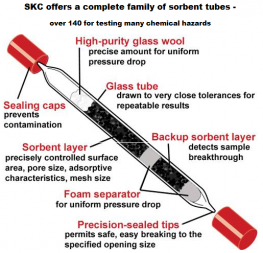Difference between revisions of "Air Sampling"
From OSHKY Knowledge Library
m Tag: visualeditor |
m Tag: visualeditor |
||
| Line 5: | Line 5: | ||
= Charcoal Tubes = | = Charcoal Tubes = | ||
''<small>From <nowiki>https://www.skcinc.com/catalog/product_info.php?products_id=567</nowiki></small>'' | ''<small>From <nowiki>https://www.skcinc.com/catalog/product_info.php?products_id=567</nowiki></small>'' | ||
| − | *[[File:Charcoal tube diagram.png|thumb|263x263px|Charcoal Tube Diagram]]Just before sampling, use a scorer/breaker tool to uniformly break the ends of the sorbent tube to a 2 mm diameter or '''''half the diameter of the tube body'''''. | + | *[[File:Charcoal tube diagram.png|thumb|263x263px|Charcoal Tube Diagram|none]]Just before sampling, use a scorer/breaker tool to uniformly break the ends of the sorbent tube to a 2 mm diameter or '''''half the diameter of the tube body'''''. |
* Keep the tube in a vertical position during sampling to prevent the possibility of '''channeling''' that can lead to under-sampling. | * Keep the tube in a vertical position during sampling to prevent the possibility of '''channeling''' that can lead to under-sampling. | ||
* The arrow on the tube indicates air flow direction and should '''point to the tube holder and pump'''. If no arrow is present, the smallest section should be near the tube holder. | * The arrow on the tube indicates air flow direction and should '''point to the tube holder and pump'''. If no arrow is present, the smallest section should be near the tube holder. | ||
Revision as of 09:36, 25 October 2017
Refer to OTM Section II Chapter 1 for core information.
Arrangements of Sampling Train
For OneNote: Explain, with pictures, the sampling train for regular setups and, especially, low-flow setups.
Charcoal Tubes
From https://www.skcinc.com/catalog/product_info.php?products_id=567
- Just before sampling, use a scorer/breaker tool to uniformly break the ends of the sorbent tube to a 2 mm diameter or half the diameter of the tube body.
- Keep the tube in a vertical position during sampling to prevent the possibility of channeling that can lead to under-sampling.
- The arrow on the tube indicates air flow direction and should point to the tube holder and pump. If no arrow is present, the smallest section should be near the tube holder.
Impinger
Video demonstrating setup and usage.
Isocyanates
Enter Isocyanate sampling methods and info about solvent stability.
Mold Sampling
Method
| Time | 2 Hours |
| Media | MCEF in 37.5mm cassette |
| Flow Rate | 2 L/min |
| Tubing | Use a short length of tubing — just long enough to be able to flex and point down. |
- The intake on the cassette always needs to be facing down so that other, heavier particles will not land on the filter.
- One pump is used outside and one pump is used inside.
Notes
- When results come back with a significantly higher fungus count (CFU/m³) for the inside as opposed to the outside count, a letter is sent to the company contact detailing the findings, the hazards, and remediation. (A template is saved in Documents.)
- The letter is printed out and submitted in the report under the IB tab.
- The digital original is sent to your supervisor so that it can be passed on to Jenifer for updating the date and for review by the Program Manager.
- Click here ???? for a more in-depth discussion of spores vs. CFU.
Respirable Dust – Cyclone
| Media | PVC | ||
|---|---|---|---|
- Media: PVC 1.7 L/min
- Using the Cyclone eliminates all particles but respirable particles.
- Using anything BUT the Cyclone will give you Total Dust.
SafeLog
- Use Form OSHA-93 Direct Reading Report.
- Carbon Monoxide (CO) has an IDLH of 1200 ppm.
- Nitrogen dioxide (NO2) has an IDLH of 20 ppm.
- Make sure to set sampling parameters as follows:
| CAL LVL | HI LVL | STEL | TWA | Comments | |
| CO | 50 | 200 | Your discretion | 50 | |
| NO₂ | 25 ? | 5 | 1 | Your choice |
† NIOSH recommended values
‡ OSHA PELs
─────
Screening
- When screening for substances with a direct read device (such as the Drager or a SafeLog), results are recorded on an OSHA-93 "Direct Reading Report" form, which details each location screened and results.
- Additionally, an OSHA-98 "Screening Report" form should be completed for all screened substances.
